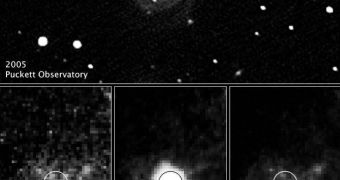Astronomical theories have thus far held that a massive star's life cycle is something that is clearly determined ever since its birth, and that there is nothing that can go amiss in the fairly simple process. Talking about celestial bodies some 100 times bigger and up to a million times brighter than the Sun, astronomers have said that they can only explode into supernovas when they develop a large enough iron core, as a byproduct of the nuclear fusion reaction inside.
Now, a new study comes to show that this may actually not be the case, as the SN 2005gl supernova, from the NGC 266 barred-spiral galaxy, has been found to have exploded way ahead of its time. This has made experts wonder if the theories concerning massive stars are, indeed, the correct ones, as that particular supernova was created by a star that was yet too young to have formed such a massive iron core.
Israeli scientist Avishay Gal-Yam, from the Weizmann Institute of Science in Rehovot, added that, “This might mean that we are fundamentally wrong about the evolution of massive stars, and that theories need revising.” What makes this supernova more fit for research than any other is the fact that it has been observed at different points in time, with different telescopes. That is to say, in 1997, the progenitor star (the original body that exploded into a supernova) was clearly visible in Hubble archive images.
However, when a new observation was carried out in 2005, the place of the progenitor had been taken by a supernova. Now, it was only recently that astronomers discovered the fact that supernovas, indeed, formed from massive stars, but at the time researchers didn't know that.
In 2007, when they looked at the same portion of the sky, they noticed that the progenitor was gone, after the supernova exploded. Knowing its origins, experts now say that there is no possible way the star could have been old enough to develop an iron core, and, as such, hypothesize that other forces may be at work to trigger a massive star's supernova explosion.
“The progenitor identification shows that, at least in some cases, massive stars explode before losing most of their hydrogen envelope, suggesting that the evolution of the core and the evolution of the envelope are less coupled than previously thought, a finding which may require a revision of stellar evolution theory,” San Diego State University researcher Douglas Leonard, who is also the co-author of a new study detailing the finds and published in the latest online edition of the journal Nature, explains.

 14 DAY TRIAL //
14 DAY TRIAL //